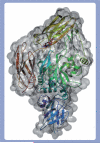Transglutaminase activation in neurodegenerative diseases
- PMID: 20161049
- PMCID: PMC2746681
- DOI: 10.2217/fnl.09.17
Transglutaminase activation in neurodegenerative diseases
Abstract
The following review examines the role of calcium in promoting the in vitro and in vivo activation of transglutaminases in neurodegenerative disorders. Diseases such as Alzheimer's disease, Parkinson's disease and Huntington's disease exhibit increased transglutaminase activity and rises in intracellular calcium concentrations, which may be related. The aberrant activation of transglutaminase by calcium is thought to give rise to a variety of pathological moieties in these diseases, and the inhibition has been shown to have therapeutic benefit in animal and cellular models of neurodegeneration. Given the potential clinical relevance of transglutaminase inhibitors, we have also reviewed the recent development of such compounds.
Figures





Similar articles
-
Possible role of the transglutaminases in the pathogenesis of Alzheimer's disease and other neurodegenerative diseases.Int J Alzheimers Dis. 2011 Feb 16;2011:865432. doi: 10.4061/2011/865432. Int J Alzheimers Dis. 2011. PMID: 21350675 Free PMC article.
-
Critical role of transglutaminase and other stress proteins during neurodegenerative processes.Amino Acids. 2010 Feb;38(2):653-8. doi: 10.1007/s00726-009-0428-3. Epub 2009 Dec 5. Amino Acids. 2010. PMID: 19960212 Review.
-
Possible involvement of transglutaminase-catalyzed reactions in the physiopathology of neurodegenerative diseases.Amino Acids. 2013 Jan;44(1):111-8. doi: 10.1007/s00726-011-1081-1. Epub 2011 Sep 22. Amino Acids. 2013. PMID: 21938398 Review.
-
Transglutaminase inhibition as a possible therapeutical approach to protect cells from death in neurodegenerative diseases.Recent Pat CNS Drug Discov. 2013 Aug;8(2):161-8. doi: 10.2174/15748898113089990001. Recent Pat CNS Drug Discov. 2013. PMID: 23688272 Review.
-
Pathogenetic Contributions and Therapeutic Implications of Transglutaminase 2 in Neurodegenerative Diseases.Int J Mol Sci. 2024 Feb 17;25(4):2364. doi: 10.3390/ijms25042364. Int J Mol Sci. 2024. PMID: 38397040 Free PMC article. Review.
Cited by
-
γ-Glutamylamines and neurodegenerative diseases.Amino Acids. 2013 Jan;44(1):129-42. doi: 10.1007/s00726-011-1209-3. Epub 2012 Mar 10. Amino Acids. 2013. PMID: 22407484 Free PMC article. Review.
-
The Different Conformational States of Tissue Transglutaminase Have Opposing Affects on Cell Viability.J Biol Chem. 2016 Apr 22;291(17):9119-32. doi: 10.1074/jbc.M115.699108. Epub 2016 Feb 18. J Biol Chem. 2016. PMID: 26893378 Free PMC article.
-
Calmodulin Binding Domains in Critical Risk Proteins Involved in Neurodegeneration.Curr Issues Mol Biol. 2022 Nov 21;44(11):5802-5814. doi: 10.3390/cimb44110394. Curr Issues Mol Biol. 2022. PMID: 36421678 Free PMC article.
-
Cystamine and cysteamine as inhibitors of transglutaminase activity in vivo.Biosci Rep. 2018 Sep 5;38(5):BSR20180691. doi: 10.1042/BSR20180691. Print 2018 Oct 31. Biosci Rep. 2018. PMID: 30054429 Free PMC article. Review.
-
Critical Evaluation of the Changes in Glutamine Synthetase Activity in Models of Cerebral Stroke.Neurochem Res. 2015 Dec;40(12):2544-56. doi: 10.1007/s11064-015-1667-1. Epub 2015 Aug 2. Neurochem Res. 2015. PMID: 26233464 Review.
References
-
- Kim SY, Grant P, Lee JH, et al. Differential expression of multiple transglutaminases in human brain. Increased expression and cross-linking by transglutaminases 1 and 2 in Alzheimer's disease. J. Biol. Chem. 1999;274:30715–33021. [■■ of considerable interestFirst study to demonstrate that at least three transglutaminases (TGs) are present in human brain and that Alzheimer's disease (AD) brain has greatly increased levels of protein crosslinks.] - PubMed
-
- Citron BA, SantaCruz KS, Davies PJA, et al. Intron–exon swapping of transglutaminase mRNA and neuronal Tau aggregation in Alzheimer's disease. J. Biol. Chem. 2001;276:3295–3301. - PubMed
-
- Wilhelmus MM, Grunberg SC, Bol JG, et al. Transglutaminases and transglutaminase-catalyzed cross-links colocalize with the pathological lesions in Alzheimer's disease brain. Brain Pathol. 2008 DOI: 10.1111/j.1750−3639.2008.00197.x. (Epub ahead of print) [■ of interestImportant demonstration of TGs and pathological lesions in AD brain.] - PMC - PubMed
-
- Hadjivassiliou M, Aeschlimann P, Strigun A, et al. Autoantibodies in gluten ataxia recognize a novel neuronal transglutaminase. Ann. Neurol. 2008;64:332–343. [■ of interestDemonstration of TG 6 in human brain.] - PubMed
-
- Lorand L, Graham RM. Transglutaminases: crosslinking enzymes with pleiotropic functions. Nat. Rev. Mol. Cell Biol. 2003;4:140–156. - PubMed
Grants and funding
LinkOut - more resources
Full Text Sources
